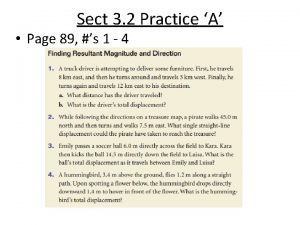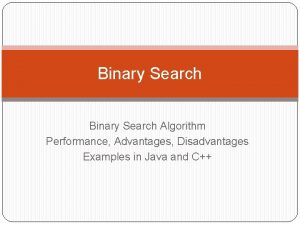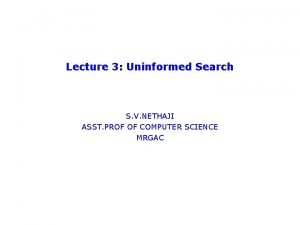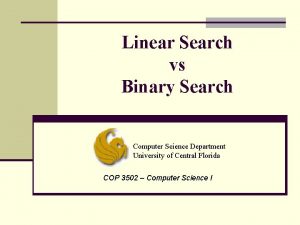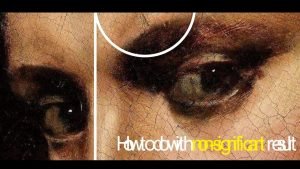In Search of the Lost Legions Attempting to















































- Slides: 47

In Search of the Lost Legions Attempting to account for Hatchery-origin steelhead returns to the Snake River Herb Pollard – NOAA –National Marine Fisheries Service Chris Starr – USFWS – Lower Snake Compensation Plan


Hatchery Origin Natural Origin

Hatchery-origin : Wild/natural Steelhead Run Composition at Lower Granite Dam 1984 -2003 Hatchery-origin Wild/naturalsteelhead Natural-origin Steelhead

Hatchery-origin : Wild/natural Steelhead Run % Composition at Lower Granite Dam 1984 -2003 Hatchery-origin steelhead adults Natural-origin steelhead adults

Concerns about Hatchery-origin Steelhead Adult Returns n Genetic concerns: • Artificial selection • Genetic introgression • Loss of fitness n Ecological Concerns • Competition for mates or spawning areas

Sometimes these concerns are expressed as: n n n “There are Tens of Thousands of unaccounted hatchery steelhead in the Snake River Basin!” “Hatchery steelhead stray randomly and impact wild steelhead throughout the basin!” “Hatchery strays are spawning with wild fish in important natural production areas, reducing fitness and adversely impacting recovery!”

Concerns for Hatchery strays in status reviews and recovery literature

n But, really, not much is known about the impact of hatchery fish on natural steelhead in the Snake River basin.

The Assignment to Fishery Managers: n n Account for the hatchery-origin steelhead that return to known sites and harvest Summarize the data for hatcheryorigin steelhead that stray between release sites or into natural production areas

Data on known removals/mortalities n n n Hatchery rack returns Harvest estimates/creel census Natural mortality Return to direct stream releases Catch and release mortality in recreational fisheries

Data on known strays/tag recoveries n n n Wild steelhead weirs in Grande Ronde, Imnaha, and Lochsa systems Hatchery weirs Coded-wire tag returns from weirs and fisheries

Genetic Evidence of hatchery introgression into natural populations n n IDFG Steelhead Genetic Survey NMFS Northwest Fishery Science Center surveys

Cooperators n n n Washington Department of Fish and Wildlife – Mark Schuck Oregon Department of Fish and Wildlife – Rich Carmichael Idaho Department of Fish and Game – Paul Kline Nez Perce Tribal Fisheries – Becky Johnson Shoshone-Bannock Tribal Fisheries – Keith Kutchins Confederated Tribes of the Umatilla Indian Reservation – Brian Zimmerman

n How many fish can be accounted for?







Distribution of Hatchery-origin Steelhead in the Snake River 1995 -2002 Weighted Average Natural Mortality 6. 4% Direct Stream 8. 7% C&R mortality 0. 8% Hatchery Rack 19. 1% Unaccounted 4. 1% Harvest 60. 9%

Distribution of Hatchery-origin Steelhead in the Snake River 1995 -2002

Unaccounted HOR NOR Escapement

So, where do they go?

Numbers of natural-origin adult steelhead and hatcheryorigin strays trapped at Grande Ronde River tributary weirs, ) 2001 -2004 (Data from Mike Mc. Lean, CTUIR Weir Site Run Year 2001 -02 2002 -03 2003 -04 Lookingglass Creek Total (Strays) 258 165 134 557 (4) Upper Grande Ronde Catherine Creek 36 56 63 155 (1) 256 226 181 663 (3) Total (Strays) 550 (5) 447 (1) 378 (2) 1, 375 (8)

Proportion of Hatchery-origin steelhead strays at three weirs in the upper Grande Ronde Subbasin 8 Hatchery strays – 0. 6% 1, 367 Wild/natural fish – 99. 4%

Stray rates in the Imnaha Basin 1999 -00 to 2003 -04 run years. Courtesy of Jay Hesse (Nez Perce Tribe). Lightning Stray rate Cow Stray rate Creek (%) SGS (%) -- 0 0. 0000 Run year Escapement 1999 -00 445 2 0. 0045 2000 -01 1, 224 2 0. 0016 4 0. 0033 0 0. 0000 2001 -02 3, 775 8 0. 0021 15 0. 0040 0 0. 0000 2002 -03 2, 417 7 0. 0029 4 0. 0017 3 0. 0012 2003 -04 3, 502 8 0. 0023 20 0. 0057 1 0. 0003

Imnaha Hatchery Returns and strays in Tributaries 74 Hatchery Strays detected in Tributaries 11, 363 Hatchery returns – 1999 -04

Fish Creek Weir: Hatchery Strays Hatchery-origin strays ~2% Natural-origin recruits

Rapid River Weir NOR: HOR NOR

n How well do the hatchery fish return to the point of release?

Cottonwood Pond – 4, 515 CWT recovered in the Snake River Basin Lyons Ferry Trap - 110 Cottonwood Trap - 781 Snake River Sport – 1, 628 Others – 60 (1. 3%) Clearwater Sport – 11 Tucannon Sport – 13 Salmon Sport - 30 Pahsimeroi – 1 Big Canyon - 5 Grande Ronde Sport – 1, 936

Wallowa-Big Canyon 4, 361 CWT Recovered in the Wallowa River Strays between Facilities - 13 Returned to Site of Release – 4, 348

Idaho Rack and Harvest Recovery of fish released at racks – 6, 361 CWT recovered in Snake river OK – Fish recovered at the release site or in fisheries downstream and en route - 6, 324 tags Not OK – Fish recovered at the wrong hatchery rack or in fisheries off the direct route – 37 tags (0. 6%)

IDFG Direct Stream Releases 1, 153 CWT In-subbasin – upstream 152 tags (13. 2%) In-subbasin downstream – 48 tags (4. 0 %) Out-of-Subbasin– downstream – 37 tags (3. 0%) OK – Recovered in area of release - 916 tags (79. 5%)

Genetic Surveys n Genetic Population Structure of Snake River Basin Steelhead in Idaho (Nielsen et al 2004) : “…significant genetic population structure remains for steelhead populations within the Snake River…”

Conclusion: Fishery managers know where most of the hatchery origin steelhead go in the Snake River Basin. n On the average, 95. 9% of the hatchery steelhead passing Lower Granite Dam are accounted in harvest, rack returns, natural mortality and returns to sites like the Little Salmon River. The number of unaccounted fish is much smaller than has been thought.

Conclusion: Once within the Snake River Basin, hatchery-origin steelhead demonstrate a high degree of homing fidelity. n n CWT detections indicate >90% return to release sites Stray rates between facilities or in fishery detections are small.

Conclusion: Detection of Hatchery strays in natural production areas is less than suspected n Weirs located on wild steelhead streams catch few hatchery fish, hatchery fish are seldom observed in spawning grounds surveys, and the ongoing genetic surveys have not reported widespread occurrence of the hatchery stocks.

Uncertainties remain. . . n n There are weirs on only a few of the important wild production streams – What about the others? If the few hatchery strays arrive in natural spawning areas, how successful are they – what are the impacts?

However…. . n Empirical data is fairly abundant and robust to indicate that straying of large numbers of hatchery steelhead into important natural production areas does not occur within the Snake River basin at the level previously thought.


Management Implications n Geographic isolation of hatchery steelhead can be an effective management measure • Release fish in main stems, away from important tributary spawning areas • Release fish in areas with good public access to increase harvest rates

Management Implications n Steelhead exhibit strong homing fidelity to release sites, but… • There may be a tendency to stray upstream or into nearby tributaries if fish are not removed

Management Implications n Acclimation ponds may not be necessary, but… • Release at a pond or tributary weir will likely help with accounting for returns • Acclimation ponds allow management options with non-migratory “residual” males

Thank you… Any Questions? n Herb Pollard, NOAA Fisheries NW Region, Hatcheries and Inland Fisheries Branch Chris Starr, US Fish and Wildlife Service, Lower Snake River Compensation Plan
 Paradise lost outline
Paradise lost outline Lost sheep lost coin lost son
Lost sheep lost coin lost son A truck driver is attempting to deliver some furniture
A truck driver is attempting to deliver some furniture A truck driver attempting to deliver some furniture
A truck driver attempting to deliver some furniture Magritte attempting the impossible
Magritte attempting the impossible Limitation of linear search
Limitation of linear search Yahoo
Yahoo Local search vs global search
Local search vs global search Which search strategy is called as blind search
Which search strategy is called as blind search Best first search in ai
Best first search in ai Linear search vs binary search
Linear search vs binary search Federated search vs distributed search
Federated search vs distributed search Tw.search.yahoo.com
Tw.search.yahoo.com Heuristik
Heuristik Space complexity bfs
Space complexity bfs Search photo
Search photo Informed search and uninformed search
Informed search and uninformed search Video.search.yahoo.com
Video.search.yahoo.com Federated discovery
Federated discovery Semantic search vs cognitive search
Semantic search vs cognitive search Httpstw
Httpstw Số nguyên tố là gì
Số nguyên tố là gì Vẽ hình chiếu vuông góc của vật thể sau
Vẽ hình chiếu vuông góc của vật thể sau đặc điểm cơ thể của người tối cổ
đặc điểm cơ thể của người tối cổ Các châu lục và đại dương trên thế giới
Các châu lục và đại dương trên thế giới Glasgow thang điểm
Glasgow thang điểm Sơ đồ cơ thể người
Sơ đồ cơ thể người ưu thế lai là gì
ưu thế lai là gì Tư thế ngồi viết
Tư thế ngồi viết Cái miệng nó xinh thế
Cái miệng nó xinh thế Mật thư anh em như thể tay chân
Mật thư anh em như thể tay chân Bổ thể
Bổ thể Tư thế ngồi viết
Tư thế ngồi viết Thẻ vin
Thẻ vin Thế nào là giọng cùng tên
Thế nào là giọng cùng tên Thơ thất ngôn tứ tuyệt đường luật
Thơ thất ngôn tứ tuyệt đường luật Hát lên người ơi
Hát lên người ơi Các châu lục và đại dương trên thế giới
Các châu lục và đại dương trên thế giới Từ ngữ thể hiện lòng nhân hậu
Từ ngữ thể hiện lòng nhân hậu Hổ đẻ mỗi lứa mấy con
Hổ đẻ mỗi lứa mấy con Diễn thế sinh thái là
Diễn thế sinh thái là Vẽ hình chiếu vuông góc của vật thể sau
Vẽ hình chiếu vuông góc của vật thể sau Làm thế nào để 102-1=99
Làm thế nào để 102-1=99 Tỉ lệ cơ thể trẻ em
Tỉ lệ cơ thể trẻ em Lời thề hippocrates
Lời thề hippocrates đại từ thay thế
đại từ thay thế Quá trình desamine hóa có thể tạo ra
Quá trình desamine hóa có thể tạo ra Công của trọng lực
Công của trọng lực



